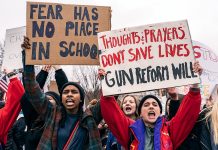The chaotic events in Ferguson, Missouri over the past week has placed the city on the proverbial map, whether the residents there like it to be or not. A medium sized suburb of around 21,000 people, one of nearly 100 which surrounds St. Louis, has become internationally known thanks to an unarmed 18 year old black man named Michael Brown being inexplicably shot to death by a white Ferguson cop.
The facts have yet to come out, and it may be a few weeks before they do, but what we do know is that Brown was walking in the middle of a street in an apartment complex called Canfield Greens on the southeastern edge of the city when a Ferguson police car pulled up. And by now, you’ve heard two different versions of what happened, one from the police, and the other from two or three witnesses which mostly corroborated with one another. And there is no dispute from either side that Brown was unarmed and was shot multiple times. The question yet to be answered is… why? What could have Brown possibly have done to provoke a cop to get out of his car and fatally shoot him as he ran away?
Brown’s motionless body was left lying in the street for hours, a river of blood trickling away from him, before finally being covered up and eventually hauled off. Residents in the apartment complex stood behind police tape, aghast at the rawness of it all. Many became very angry at the lack of dignity being shown, and of course Brown’s mother and grandmother were hysterical once they found out what had happened to him.
But the undercurrent of what happened couldn’t be overlooked. A young black man was shot dead by a white cop. Had it been a black cop, you probably would have never heard of Ferguson, Missouri. You’d never would have learned that the suburb, at one time an idyllic place to live and grow up, had become 70% black while suffering from an economic decline that includes falling housing prices and high unemployment, particularly for blacks.
But Ferguson is not a bad place, although the images you have seen on television no doubt makes it seem that way. The town was started in the mid 1800s and built up around a railroad depot. And it eventually became home to a few executive homes back when Ferguson was a quaint little town a short distance away from booming, bustling St. Louis. The area would slowly build up until the first wave of White Flight occurred in the aftermath of World War II, at which point many subdivisions featuring ranch style homes sprung up. Many white families fled the crowded city of St. Louis and moved into places like Ferguson, and the population grew from 5,700 in 1940 to a peak of 29,000 in 1970. Emerson Electric located their world headquarters there in the 1950’s and there were an abundance of manufacturing jobs both in the city of St. Louis and in north St. Louis county, where Ferguson is located. River Roads Mall and Northland Shopping Center in Jennings, which borders Ferguson on the southeast and abuts the northwest border of St. Louis, were popular destinations for Ferguson residents.





